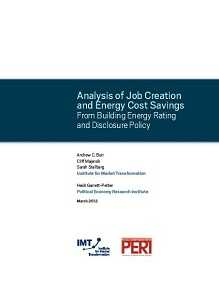Major U.S. cities and states, including New York City, San Francisco, the District of Columbia, and California, now require building owners and operators to comparatively rate the energy performance of their buildings and disclose building energy-performance indicators to the marketplace. Existing policies are projected to impact more than 4 billion square feet of floor space annually by 2014, and similar policies are being considered in more than 10 other states and local jurisdictions.
This study, by IMT and the Political Economy Research Institute (PERI) at the University of Massachusetts, Amherst, analyzes the potential of a national building energy rating and disclosure policy to create jobs and reduce energy-related expenditures in commercial and multifamily residential buildings. The analysis predicts such a policy would yield the following results:
Create more than 23,000 net new jobs in 2015 and more than 59,000 jobs in 2020, resulting from increased demand for energy efficiency services and technologies, and from the reinvestment of energy cost savings by consumers and businesses into the economy
- Reduce energy costs for building owners, consumers, and businesses by approximately $3.8 billion through 2015 and more than $18 billion through 2020
- Generate more than $7.8 billion in private investment in energy efficiency measures through 2020, yielding $3 to $4 in energy cost savings for every dollar invested
- Reduce annual energy consumption in the U.S. building sector by approximately 0.2 quadrillion Btus by 2020, equal to taking more than 3 million cars off the road each year.
See also: Energy Disclosure & the New Frontier for American Jobs
